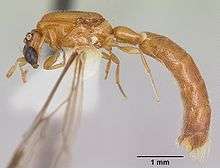Aenictogiton
Aenictogiton is a genus of ants, comprising seven rarely collected species.[2] All of the species are known only from males from Central Africa, and show a morphological and phylogenetic affinity to the army ant genus Dorylus.[2] The dorylomorph ants include six subfamilies– Aenictogitoninae, Cerapachyinae, Leptanilloidinae, and the three army ant subfamilies Aenictinae, Dorylinae and Ecitoninae.[3]
| Aenictogiton | |
|---|---|
 | |
| Aenictogiton sp. male from Zambia | |
| Scientific classification | |
| Kingdom: | |
| Phylum: | |
| Class: | |
| Order: | |
| Family: | |
| Subfamily: | |
| Genus: | Aenictogiton Emery, 1901 |
| Type species | |
| Aenictogiton fossiceps | |
| Diversity[1] | |
| 7 species | |
Origin
Army ants predominantly reside in tropical and subtropical areas of Africa, the Americas, Asia, and Indo‐Australia, however, a few species range into more temperate regions. The Ecitoninae all reside in the New World with an exception to two army ant subfamilies that are located in the Old World. Most of the species are located in Oriental and Indo‐Australian regions and a small variety in the Afrotropical region.[4][5]
Behavioral and Reproductive Traits
All species within the three army ant subfamilies have similar behavioral and reproductive traits such as, obligate collective foraging, nomadism, and highly modified queens called dichthadiigynes.[6] Aenictogiton or army ants never forage or hunt alone, they instead use leaderless, co-operative mass of ants to overwhelm their prey all at once. The army ants never reside in one location and do not build permanent nests. Therefore, they forage and hunt in different locations and emigrate periodically.[7] The Queen are wingless and contain expandable abdomens that allow them to produce millions of eggs per month, which allows variation to occur within the species.[7]
Species
- Aenictogiton attenuatus Santschi, 1919
- Aenictogiton bequaerti Forel, 1913
- Aenictogiton elongatus Santschi, 1919
- Aenictogiton emeryi Forel, 1913
- Aenictogiton fossiceps Emery, 1901 (type species)[8]
- Aenictogiton schoutedeni Santschi, 1924
- Aenictogiton sulcatus Santschi, 1919
References
- Bolton, B. (2014). "Aenictogiton". AntCat. Retrieved 17 July 2014.
- Brady, Seán G.; Ted R. Schultz; Brian L. Fisher; Philip S. Ward (2006-11-01). "Evaluating alternative hypotheses for the early evolution and diversification of ants". Proceedings of the National Academy of Sciences. National Academy of Sciences. 103 (48): 18172–18177. doi:10.1073/pnas.0605858103. PMC 1838725. PMID 17079492.
- Bolton, Barry (December 1990). "Army ants reassessed: the phylogeny and classification of the doryline section (Hymenoptera, Formicidae)". Journal of Natural History. 24 (6): 1339–1364. doi:10.1080/00222939000770811. ISSN 0022-2933.
- II, Julian F. Watkins (1974-09-23). "Neivamyrmex angulimandibulatus, New Species (Formicidae: Dorylinae) from Cordoba, Mexico". The Southwestern Naturalist. 19 (3): 309–312. doi:10.2307/3669936. ISSN 0038-4909. JSTOR 3669936.
- Maes, Dirk (2007-10-24). "James T. Costa, The Other Insect Societies". Journal of Insect Conservation. 12 (5): 579–580. doi:10.1007/s10841-007-9118-1. ISSN 1366-638X.
- Wilson, E. O. (March 1958). "Observations on the behavior of the Cerapachyine ants". Insectes Sociaux. 5 (1): 129–140. doi:10.1007/bf02222432. ISSN 0020-1812.
- Brady, S. G. (2003-05-15). "Evolution of the army ant syndrome: The origin and long-term evolutionary stasis of a complex of behavioral and reproductive adaptations". Proceedings of the National Academy of Sciences. 100 (11): 6575–6579. Bibcode:2003PNAS..100.6575B. doi:10.1073/pnas.1137809100. ISSN 0027-8424. PMC 164488. PMID 12750466.
- "Genus: Aenictogiton". AntWeb. Retrieved 16 July 2010.
External links

